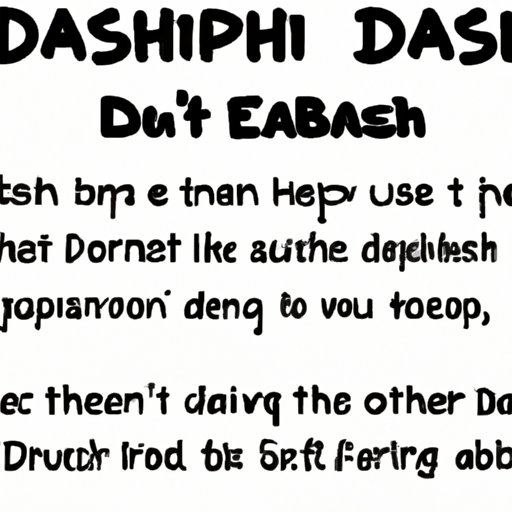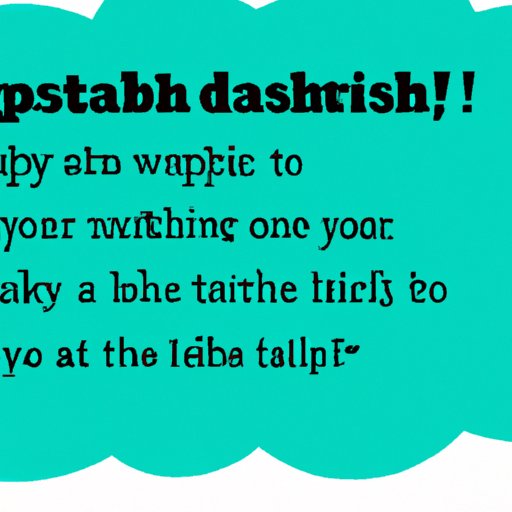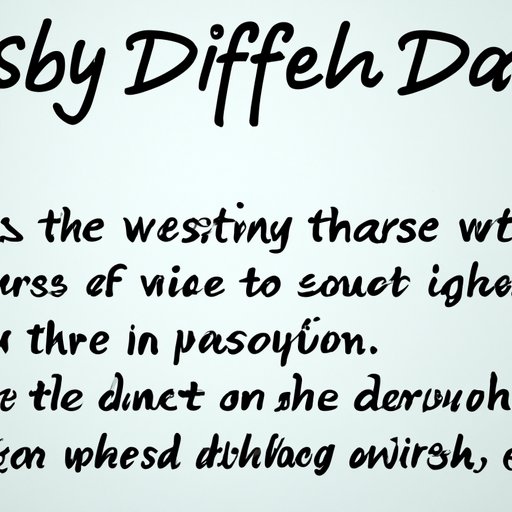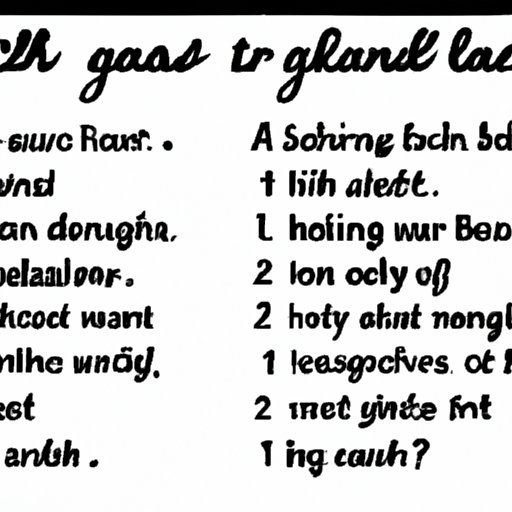Introduction
Dashes are an essential part of writing and can help add clarity and emphasis to sentences. But understanding when to use a dash in writing and how to use it correctly can be confusing. This article will explain the different types of dashes used in writing, provide examples of when to use a dash, offer guidelines for proper usage, discuss common mistakes to avoid, and provide tips on how to incorporate a dash effectively into your writing.
Explaining Different Types of Dashes Used in Writing
The three main types of dashes used in writing are the em dash (—), the en dash (–), and the hyphen (-).
Em Dash (—)
An em dash is the longest of the three types of dashes. It is used to indicate an abrupt change in thought or to set off an explanatory clause or phrase. Em dashes can also be used to emphasize a word or phrase.
En Dash (–)
An en dash is slightly shorter than an em dash and is used to separate items in a list or series. For example, you can use an en dash to indicate a range, such as 2–5 or January–March.
Hyphen (-)
The hyphen is the shortest of the three types of dashes. It is mainly used to combine words, such as “self-help” or “high-quality.”
Examples of When to Use a Dash in Writing
Now that you know the different types of dashes used in writing, let’s take a look at some examples of when to use a dash.
To Indicate an Abrupt Change in Thought
An em dash can be used to indicate an abrupt change in thought. For example, if you were writing the sentence “I wanted to go to the store—but I changed my mind,” you would use an em dash to show the sudden change in thought.
To Separate Items in a List or Series
An en dash can be used to separate items in a list or series. For example, you could write “I need to buy milk, eggs, bread, and butter–all of which are staples in my kitchen.”
To Set Off an Explanatory Clause or Phrase
An em dash can also be used to set off an explanatory clause or phrase. For example, if you were writing the sentence “It was a difficult decision–one that I have been struggling with for months,” you would use an em dash to show the explanatory clause.
To Emphasize a Word or Phrase
An em dash can be used to emphasize a word or phrase. For example, if you were writing the sentence “I am passionate about teaching–it’s my life’s work,” you would use an em dash to emphasize the word “teaching.”
Guidelines for Properly Using a Dash in Writing
Now that you know when to use a dash in writing, let’s take a look at some guidelines for properly using a dash.
Do Not Overuse Dashes
It is important to remember not to overuse dashes in your writing. Although they can be useful for adding emphasis and clarity, too many dashes can make your writing seem choppy and disjointed.
Do Not Use Dashes as Substitutes for Commas, Colons, Parentheses, or Semicolons
It is also important to remember not to use dashes as substitutes for commas, colons, parentheses, or semicolons. Each type of punctuation has its own purpose and should be used accordingly.
Use Dashes Sparingly and Only When Needed
Finally, it is important to remember to use dashes sparingly and only when needed. Dashes should not be used just for the sake of using them; instead, they should be used to add emphasis and clarity to your writing.

Common Mistakes to Avoid When Utilizing a Dash
Now that you know how to properly use a dash in writing, let’s take a look at some common mistakes to avoid.
Incorrect Use of Punctuation
One of the most common mistakes people make when utilizing a dash is using the wrong type of punctuation. It is important to remember that each type of punctuation has its own purpose and should be used accordingly.
Overusing Dashes
Another common mistake people make when utilizing a dash is overusing them. Remember, dashes should be used sparingly and only when needed; otherwise, your writing may become choppy and disjointed.
Not Using Dashes Correctly
Finally, it is important to remember to use dashes correctly. Make sure the dash is placed between two related but independent clauses and that it is used correctly in the context of the sentence.

Tips on How to Incorporate a Dash Effectively into Your Writing
Now that you know the common mistakes to avoid when utilizing a dash, let’s take a look at some tips on how to incorporate a dash effectively into your writing.
Read Your Work Aloud and Listen for Pauses That May Need a Dash
Reading your work aloud and listening for pauses that may need a dash can be a great way to determine when to use a dash. If you find yourself pausing while reading your work, chances are you need to use a dash.
Make Sure the Dash Is Used Correctly in the Context of the Sentence
It is important to make sure the dash is used correctly in the context of the sentence. A dash should not be used as a substitute for other punctuation marks. Make sure you are using the correct type of punctuation for the sentence.
Make Sure the Dash Is Placed Between Two Related but Independent Clauses
When using a dash, make sure it is placed between two related but independent clauses. For example, if you were writing the sentence “I wanted to go to the store—but I changed my mind,” you would use an em dash to show the sudden change in thought.

Benefits of Knowing When to Use a Dash in Writing
Knowing when to use a dash in writing can be beneficial in a variety of ways.
Creating Emphasis
One of the primary benefits of knowing when to use a dash in writing is being able to create emphasis. An em dash can be used to emphasize a word or phrase, which can add clarity and impact to your writing.
Adding Clarity to Sentences
Using a dash correctly can also add clarity to sentences. An em dash can be used to indicate an abrupt change in thought or to set off an explanatory clause or phrase, which can help make your writing more clear and concise.
Breaking Up Long Sentences or Lists
Finally, using a dash correctly can help break up long sentences or lists. An en dash can be used to separate items in a list or series, which can help make your writing easier to read and understand.
Conclusion
Dashes are an essential part of writing and can help add clarity and emphasis to sentences. Understanding when to use a dash in writing and how to use it correctly can be confusing, but with this article as a guide, you can learn the different types of dashes used in writing, examples of when to use a dash, guidelines for proper usage, common mistakes to avoid, and tips for incorporating them effectively into your writing.
(Note: Is this article not meeting your expectations? Do you have knowledge or insights to share? Unlock new opportunities and expand your reach by joining our authors team. Click Registration to join us and share your expertise with our readers.)
